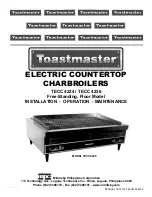
WHL-016 Rev. 4.14.16
15
Part 4 - Piping
Failure to follow the instructions in this section WILL VOID the
warranty and may result in property damage, severe personal
injury, or death.
Dielectric unions or galvanized steel fittings must not be used
in a system with this boiler. Doing so WILL VOID the warranty.
Use only copper, brass, or stainless steel fittings. Teflon thread
sealant must be used on all connections.
The National Standard Plumbing Code, the National Plumbing
Code of Canada, and the Uniform Plumbing Code limit heat
transfer fluid pressure to less than the minimum working
pressure of the potable water system up to 30 PSI maximum.
In addition, the heat transfer fluid must be water or another
non-toxic fluid having a toxicity of Class 1, as listed in Clinical
Toxicology of Commercial Products, 5th Edition. Failure to
follow this warning could result in property damage, severe
personal injury, or death.
A. General Plumbing Information
Use two wrenches when tightening water piping at boiler. Use
one wrench to prevent the boiler return or supply line from
turning. Failure to prevent piping connections from turning
could cause damage to boiler components.
The building piping system must meet or exceed the the
piping requirements in this manual.
NOTE:
The addition of a high temperature limiting device is
important if the boiler is to be connected to a domestic hot
water system.
C. Backflow Preventer
Use a backflow preventer specifically designed for hydronic
boiler installations. This valve should be installed on the cold
water fill supply line per local codes.
B. Relief Valve
To avoid water damage or scalding due to relief valve
operation:
•
Discharge line must be connected to relief valve outlet
and run to a safe place of disposal. Terminate the
discharge line in a manner that will prevent possibility
of severe burns or property damage should the relief
Plumbing of this product should only be done by a qualified,
licensed plumber in accordance with all local plumbing codes.
The boiler may be connected to an indirect water heater to
supply domestic hot water. Westinghouse offers indirect
water heaters in a wide range of gallon sizes in either stainless
steel or glass-lined construction.
Connect discharge piping to a safe disposal location following
the guidelines below.
valve discharge.
•
Discharge line must be as short as possible and the same
size as the valve discharge connection throughout its
entire length.
•
Discharge line must pitch downward from the valve
and terminate at least 6” above the floor drain, making
discharge clearly visible.
•
The discharge line shall terminate plain, not threaded,
with a material serviceable for temperatures of 375
o
F or
greater.
•
Do not pipe discharge to any location where freezing
could occur.
•
No valve may be installed between the relief valve and
boiler or in the discharge line. Do not plug or place any
obstruction in the discharge line.
•
Test the operation of the relief valve after filling and
pressurizing the system by lifting the lever. Make sure
the valve discharges freely. If the valve fails to operate
correctly, immediately replace with a new properly rated
relief valve.
•
Test T&P valve at least once annually to ensure the
waterway is clear. If valve does not operate, turn the
boiler “off” and call a plumber immediately.
•
Take care whenever operating relief valve to avoid
scalding injury or property damage.
FAILURE TO COMPLY WITH THE ABOVE GUIDELINES
COULD RESULT IN FAILURE OF RELIEF VALVE OPERATION,
RESULTING IN POSSIBILITY OF SUBSTANTIAL PROPERTY
DAMAGE, SEVERE PERSONAL INJURY, OR DEATH.
RE-INSPECTION OF T&P RELIEF VALVES: T&P valves should
be inspected AT LEAST ONCE EVERY THREE YEARS, and
replaced if necessary,
by a licensed plumbing contractor or
qualified service technician to ensure that the product has not
been affected by corrosive water conditions and to ensure that
the valve and discharge line have not been altered or tampered
with illegally. Certain naturally occuring conditions may corrode
the valve and its components over time, rendering the valve
inoperative. Such conditions can only be detected if the valve
and its components are physically removed and inspected.
Do not attempt to conduct an inspection on your own.
Contact your plumbing contractor for a re-inspection to assure
continued safety.
Do not thread a cap or plug into the relief valve or relief valve
line under any circumstances! Explosion and property damage,
serious injury, or death may result.
FAILURE TO RE-INSPECT THE T&P VALVE AS DIRECTED
COULD RESULT IN UNSAFE TEMPERATURE AND/OR
PRESSURE BUILD-UP WHICH CAN RESULT IN PROPERTY
DAMAGE, SERIOUS PERSONAL INJURY, OR DEATH.
The control module uses temperature sensors to provide both
high limit protection and modulating temperature control.
The control module may also provide low water protection
(through the addition of an optional kit) by sensing the water
level in the heat exchanger. An optional flow switch may be
installed on the supply of the system to activate the boiler
when there is enough flow. Some codes/jurisdictions may
require additional external controls.
D. Potable Expansion Tank
Expansion Tank and Make-Up Water
1. Ensure that the expansion tank is sized to correctly handle
boiler and system water volume and temperature.
Summary of Contents for WBC 399
Page 14: ...WHL 016 Rev 4 14 16 14 Figure 6 Boiler Dimensions NOTE All Dimensions Are Approximate 055 080 ...
Page 21: ...WHL 016 Rev 4 14 16 21 Figure 9 Piping Symbol Legend ...
Page 42: ...WHL 016 Rev 4 14 16 42 Figure 33 Internal Connection Diagram ...
Page 65: ...WHL 016 Rev 4 14 16 65 Figure 37 Combustion System Replacement Parts 55 110kBTU Models ...
Page 67: ...WHL 016 Rev 4 14 16 67 Figure 39 Combustion System Replacement Parts 155 399kBTU Models ...
















































